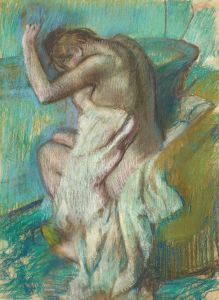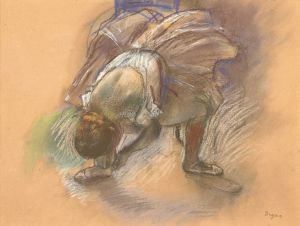
Toilette after the Bath
A hand-painted replica of Edgar Degas’s masterpiece Toilette after the Bath, meticulously crafted by professional artists to capture the true essence of the original. Each piece is created with museum-quality canvas and rare mineral pigments, carefully painted by experienced artists with delicate brushstrokes and rich, layered colors to perfectly recreate the texture of the original artwork. Unlike machine-printed reproductions, this hand-painted version brings the painting to life, infused with the artist’s emotions and skill in every stroke. Whether for personal collection or home decoration, it instantly elevates the artistic atmosphere of any space.
Edgar Degas, a prominent French artist associated with the Impressionist movement, is renowned for his innovative approach to capturing modern life, particularly through his depictions of dancers, women, and scenes of everyday life. One of his notable works, "Toilette after the Bath," exemplifies his fascination with the intimate and private moments of women, a recurring theme in his oeuvre.
"Toilette after the Bath" is part of a series of works by Degas that explore the theme of women bathing, a subject that he revisited numerous times throughout his career. These works are characterized by their candid and unidealized portrayal of the female form, often capturing women in moments of vulnerability and introspection. Degas's approach to these scenes was both innovative and controversial, as he eschewed the traditional, romanticized depictions of the nude in favor of a more realistic and sometimes stark representation.
In "Toilette after the Bath," Degas employs a combination of pastels and other media, a technique he mastered and used extensively in his later years. The use of pastels allowed Degas to achieve a softness and fluidity in his depiction of the human form, as well as to experiment with color and texture. This medium also enabled him to capture the nuances of light and shadow, which play a crucial role in the composition of the piece.
The composition of "Toilette after the Bath" is notable for its unconventional perspective and cropping, a hallmark of Degas's style. The viewer is positioned as an observer of a private moment, with the subject often partially obscured or viewed from an unusual angle. This approach creates a sense of immediacy and intimacy, drawing the viewer into the scene. Degas's interest in photography and Japanese prints, both of which influenced his compositional choices, is evident in the way he frames his subjects and captures fleeting moments.
Degas's depiction of women in "Toilette after the Bath" and similar works has been the subject of much scholarly discussion. Some critics have interpreted these works as a commentary on the voyeuristic nature of art and the male gaze, while others view them as a celebration of the beauty and complexity of the female form. Regardless of interpretation, these works remain a testament to Degas's skill as an artist and his ability to capture the subtleties of human experience.
Throughout his career, Degas maintained a keen interest in the human figure, and his works continue to be celebrated for their technical mastery and emotional depth. "Toilette after the Bath" is a prime example of his ability to blend traditional artistic techniques with modern sensibilities, resulting in a body of work that remains influential and relevant to this day.


















